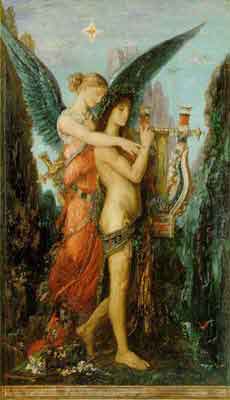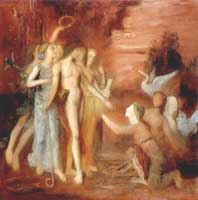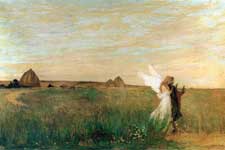.
First get an ox, then a woman. Hesiod, Works and Days

Hesiod (Hesiodos, Ἡσίοδος), the early Greek poet and rhapsode, believed to have lived around the year 700 BC. From the 5th century BC literary historians have debated the priority of Hesiod or of Homer but there is no definitive answer.
Hesiod lived in Boeotia and regularly visited Mt Helicon, the mythological home of the Muses, who, he says, gave him the gift of poetic creation one day while he tended sheep.
As with Homer, legendary traditions have accumulated around Hesiod. Unlike Homer, however, some biographical details have survived: a few details of Hesiod's life come from three references in Works and Days; some further inferences are derived from his Theogony. Hesiod lived in Boeotia. His father came from Cumes in Aeolia, which lay between Ionia and the Troad in southwestern Anatolia, but crossed the sea to settle at Ascra, "a cursed place, cruel in winter, hard in summer, never pleasant" (Works, 640). Hesiod's patrimony there, a small piece of ground at the foot of Mount Helicon, occasioned a lawsuit with his brother Perses, who won; some scholars have seen Perses as a literary creation, a foil for the moralizing that Hesiod directed to him in Works and Days
The Muses traditionally lived on Helicon, and they gave Hesiod the gift of poetic inspiration one day while he tended sheep (compare the legend of Cædmon). In another biographical detail, Hesiod mentions a poetry contest at Chalcis in Euboea where the sons of one Amiphidamas awarded him a tripod (ll.654-662). Plutarch first identified this passage as an interpolation into Hesiod's original work, based on his identification of Amiphidamas with the hero of the Lelantine War between Chalcis and Eretria, which occurred around 705 BC. The account of this contest inspired the later tale of a competition between Hesiod and Homer.
Two different -- yet early -- traditions record the site of Hesiod's grave. One, as early as Thucydides, reported in Plutarch, the Suda and John Tzetzes, states that the Delphic oracle warned Hesiod that he would die in Nemea, and so he fled to Locris, where he was killed at the local temple to Nemean Zeus, and buried there. This tradition follows a familiar ironic convention: the oracle that predicts accurately after all.
The other tradition, first mentioned in an epigram of Chersios of Orchomenus written in the 7th century BC (within a century or so of Hesiod's death) claims that Hesiod lies buried at Orchomenus, a town in Boeotia. According to Aristotle's Constitution of Orchomenus, when the Thespians ravaged Ascra, the villagers sought refuge at Orchomenus, where, following the advice of an oracle, they collected the ashes of Hesiod and placed them in a place of honour in their agora, beside the tomb of Minyas, their eponymous founder, and in the end came to regard Hesiod too as their "hearth-founder" (οἰκιστής / oikistês).
Later writers attempted to harmonize these two accounts.
Legends that accumulated about Hesiod came from several sources: a treatise "The poetic contest (Ἀγών / Agôn) of Homer and Hesiod"; a vita of Hesiod by the Byzantine grammarian John Tzetzes; the entry for Hesiod in the Suda; two passages and some scattered remarks in Pausanias (IX, 31.3–6 and 38.3–4); a passage in Plutarch Moralia (162b).
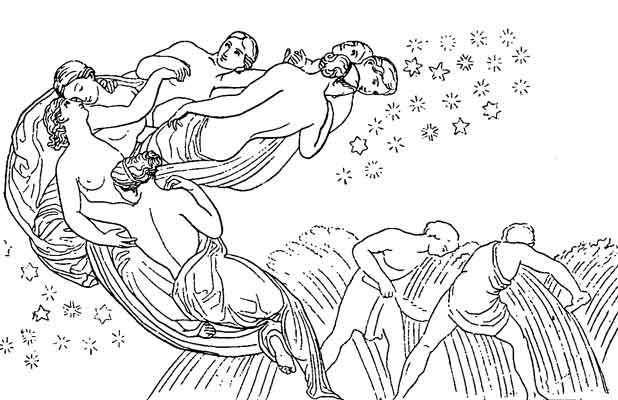
Pleiades, adapted from Flaxman , inspired by Hesiod's Works and Days:.
When the Pleiades, daughters of Atlas, are rising, begin your harvest...
Works
Hesiod wrote only one poem universally considered authentic: the Works and Days; but the Theogony, if not by Hesiod, resembles it very closely in style and substance considering the purposely different subject-matter.
The poem Works and Days lays out the five Ages of Man, as well as containing advice and wisdom, prescribing a life of honest work and attacking idleness and unjust judges (like those who decided in favour of Perses)
The Theogony concerns the origins of the world and of the gods, and shows a special interest in genealogy.
Classical authors also attributed to Hesiod later genealogical poems -- known as Catalogues of Women or as Eoiae (because sections began with the Greek words e oie 'or like her'). Only small fragments of these have survived. They deal with the genealogies of kings and heroes of the legendary heroic period. Scholars generally classify them as later examples of the poetic tradition to which Hesiod belonged. A final poem traditionally attributed to Hesiod, The Shield of Heracles, apparently forms a late expansion of one of these genealogical poems.
Hesiod serves as a major source for knowledge of Greek mythology, of farming techniques, of archaic Greek astronomy and of ancient time-keeping.
Pausanias
The Boeotians dwelling around Helicon hold the tradition that Hesiod wrote nothing but the Works, and even of this they reject the prelude to the Muses, saying that the poem begins with the account of the Strifes. They showed me also a tablet of lead where the spring is, mostly defaced by time, on which is engraved the Works.
There is another tradition, very different from the first, that Hesiod wrote a great number of poems; the one on women, the one called the Great Eoeae, the Theogony, the poem on the seer Melampus, the one on the descent to Hades of Theseus and Perithous, the Precepts of Chiron, professing to be for the instruction of Achilles, and other poems besides the Works and Days. These same Boeotians say that Hesiod learnt seercraft from the Acarnanians, and there are extant a poem called Mantica (Seercraft), which I myself have read, and interpretations of portents.
Opposite stories are also told of Hesiod's death. All agree that Ctimenus and Antiphus, the sons of Ganyctor, fled from Naupactus to Molycria because of the murder of Hesiod, that here they sinned against Poseidon, and that in Molycria their punishment was inflicted. The sister of the young men had been ravished; some say the deed was Hesiod's, and others that Hesiod was wrongly thought guilty of another's crime.
So widely different are the traditions of Hesiod himself and his poems.
Links
Other Sources
Perseus Classics Collection: Greek and Roman Materials: Text: Hesiod (http://www.perseus.tufts.edu/cgi-bin//perscoll?.submit=Change&collection=Perseus%3Acollection%3AGreco-Roman&type=text&lang=Any&lookup=Hesiod) (Greek texts and English translations for Works and Days, Theogony, and Shield of Heracles with additional notes and cross links.)
Versions of the electronic edition of Evelyn-White's English translation edited by Douglas B. Killings, June 1995:
Project Gutenberg plain text (http://www.gutenberg.net/etext/348).
Berkeley Digital Library SunSITE: The Online Medieval and Classical Library: Hesiod (http://sunsite.berkeley.edu/OMACL/Hesiod)
Sacred Texts: Classics: The Works of Hesiod (http://www.sacred-texts.com/cla/hesiod/index.htm) (Theogony and Works and Days only)
2005
Decoded at last: the 'classical holy grail' that may rewrite the history of the world
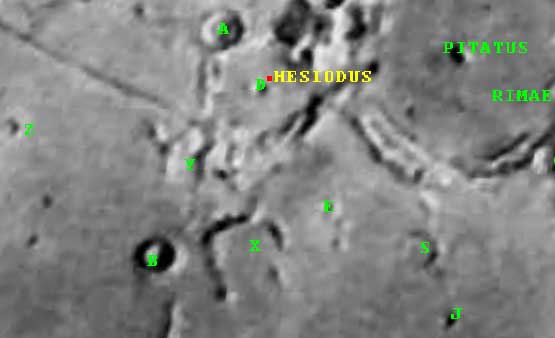
Lunar Crater Hesiodus
Timeline related to Ancient Greek Literature
Anthony Edwards, Hesiod's Ascra , University of California Press 2004 ISBN: 0520236580
Albin Lesky, A History of Greek Literature- , Hackett Publishing Company; Reprint edition (November, 1996)
| Ancient Greece
Science, Technology , Medicine , Warfare, , Biographies , Life , Cities/Places/Maps , Arts , Literature , Philosophy ,Olympics, Mythology , History , Images Medieval Greece / Byzantine Empire Science, Technology, Arts, , Warfare , Literature, Biographies, Icons, History Modern Greece Cities, Islands, Regions, Fauna/Flora ,Biographies , History , Warfare, Science/Technology, Literature, Music , Arts , Film/Actors , Sport , Fashion --- |
Retrieved from "http://en.wikipedia.org"
All text is available under the terms of the GNU Free Documentation License

